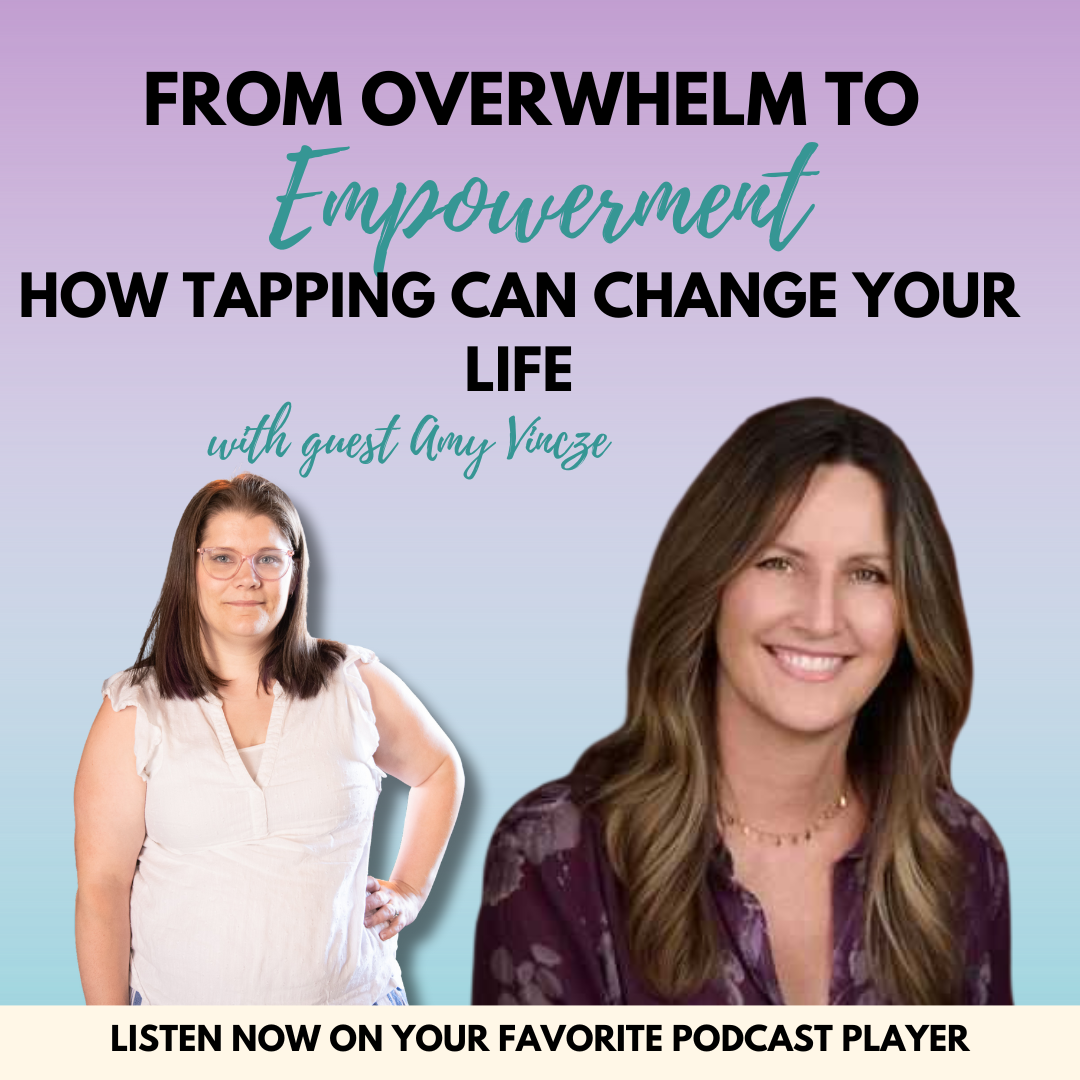
From Overwhelm to Empowerment: How Tapping Can Change Your Life
In this inspiring episode of Mamahood After Trauma, host Emily welcomes Amy, a trauma survivor and mother, who shares her journey of healing from childhood abandonment and breast cancer.
Amy discusses how Emotional Freedom Technique (tapping) helped her address deep-rooted fears and transform anxiety into resilience. She emphasizes the importance of self-awareness, curiosity, and community in the healing process, and introduces her app, Soar with Tapping, designed to guide users toward lasting emotional freedom.
Listeners are encouraged to approach their healing with patience and compassion, knowing they are not alone on their journey.

Table of Contents
Introduction and Welcome (00:00:00) Emily introduces the podcast, offers a free resource, and welcomes guest Amy.
Amy’s Background and Early Trauma (00:01:29) Amy shares her childhood experience with her father's alcoholism and abandonment, and its impact on her self-worth.
Breast Cancer Diagnosis and Emotional Healing (00:02:54) Amy discusses her breast cancer diagnosis at 31, her curiosity about its causes, and her journey into emotional healing.
Discovery of Tapping and Initial Challenges (00:04:21) Amy describes discovering tapping (EFT), getting certified, and facing limited success at first.
Crisis Point and Deep Healing with Tapping (00:05:31) Amy recounts a personal crisis, using tapping daily, and uncovering her core fear of abandonment and rejection.
Transformation and Sharing Tapping (00:06:46) Amy explains how healing her foundational fear changed her life and inspired her to help others with tapping.
Excavating to the Root of Fear (00:07:20) Amy and Emily discuss the process of identifying and addressing root fears, especially for mothers feeling overwhelmed.
Motherhood, Identity, and Trauma (00:09:33) Amy connects her feelings of invisibility and overwhelm in motherhood to her childhood trauma and threatened identity.
Self-Awareness and Curiosity in Healing (00:11:58) The importance of moving from self-judgment to curiosity and building self-awareness as a healing muscle.
Role of Community in Healing (00:12:55) Amy reflects on her limited community support, the challenges of vulnerability, and the value of finding safe people.
Vulnerability, Emotional Flexibility, and Connection (00:14:50) Discussion on the risks and rewards of vulnerability, emotional flexibility, and the power of authentic connection.
The Nonlinear, Lifelong Healing Journey (00:17:28) Emily and Amy emphasize that healing is a long, individual process, and comparison is unhelpful.
Introduction to Tapping as a Tool (00:20:03) Amy introduces tapping (EFT), its three aspects, and how it helps regulate the nervous system.
How Tapping Works Scientifically (00:21:06) Amy explains the science behind tapping, its effect on the amygdala, and reducing stress and anxiety.
Amy’s Tapping App and Core Healing (00:24:39) Amy describes her app, its focus on core healing, and how it guides users to address deep emotional issues.
Tips for Using Tapping and Emotional Release (00:27:31) Amy encourages listeners to try tapping, be open-minded, and explains how it helps release intense emotions.
App Details and How to Connect (00:28:41) Amy shares the app name, where to find it, and how listeners can connect with her online.
Closing and Final Encouragement (00:29:36) Emily thanks Amy, wraps up the episode, and reminds listeners they are not alone in their healing journey.
Healing After Trauma: Deep Insights and Actionable Tools for Mothers
Motherhood After Trauma is a podcast dedicated to supporting mothers navigating the complex journey of healing from trauma. In a recent episode, host Emily welcomes Amy, a trauma survivor, mother, and Emotional Freedom Technique (EFT) practitioner. Amy’s story is one of resilience, self-discovery, and the transformative power of practical healing tools. This blog post distills the episode’s main themes and actionable advice, offering a comprehensive guide for listeners seeking to reclaim peace and emotional freedom after trauma.
Understanding the Roots of Trauma
Amy’s journey began with childhood experiences of abandonment and unworthiness, stemming from her father’s alcoholism and departure. These early wounds shaped her worldview, leading to persistent feelings of unworthiness and a fear of rejection.
Key Insights:
- Childhood trauma often creates deep-seated beliefs (“I am unlovable,” “I am to blame”) that influence adult behavior and emotional responses.
- Physical health can be impacted by unresolved trauma. Amy’s breast cancer diagnosis at 31 prompted her to explore the mind-body connection, recognizing how chronic anxiety and depression may contribute to illness.
- Surface emotions often mask deeper fears. For example, feeling overwhelmed as a mother may actually be rooted in a fear of invisibility or abandonment.
Actionable Advice:
- Reflect on your earliest memories of pain or abandonment. What beliefs did you form about yourself as a result?
- Notice recurring emotional patterns—are there deeper fears beneath your surface reactions?
The Power of Curiosity and Self-Awareness
Amy describes herself as a lifelong “seeker,” always questioning why she felt and reacted differently than others. This curiosity became a catalyst for her healing.
Key Insights:
- Self-awareness is the foundation of healing. Trauma survivors often operate in survival mode, making it difficult to pause and reflect.
- Curiosity, not judgment, is essential. Instead of criticizing yourself for your reactions, ask, “Why am I feeling this way? What is this emotion trying to tell me?”
- Excavating root fears requires detective work. Amy’s breakthrough came when she traced her fear of failure back to a more fundamental fear of abandonment.
Actionable Advice:
- Practice journaling with prompts like, “What am I really afraid of?” or “What does this feeling remind me of from my past?”
- When triggered, pause and ask yourself, “What’s beneath this emotion?”
Community and Connection in Healing
While Amy found moments of connection at events like Tony Robbins seminars, she often preferred solitude, fearing vulnerability and judgment. Yet, she acknowledges the profound importance of community in the healing process.
Key Insights:
- Isolation reinforces feelings of being alone in your struggles. Trauma survivors often believe they are uniquely broken, which is rarely true.
- Safe, nonjudgmental relationships are vital. Even one supportive person can make a significant difference.
- Vulnerability is risky but rewarding. Sharing your story can lead to deeper connection and healing, despite the fear of judgment.
Actionable Advice:
- Identify one person in your life who feels safe and practice sharing a small piece of your story.
- Seek out support groups or online communities for trauma survivors or mothers.
Tapping (EFT): A Science-Backed Tool for Emotional Regulation
Amy’s discovery of tapping (Emotional Freedom Technique) was a turning point. She became certified in EFT and now uses it as a cornerstone of her healing practice.
What is Tapping?
- EFT combines three elements:
- Energy therapy: Tapping on acupressure points.
- Cognitive therapy: Talking through the issue while tapping.
- Somatic therapy: Engaging the body to process emotions.
How Does It Work?
- Regulates the nervous system: Tapping signals the amygdala (the brain’s fear center) to calm down, reducing cortisol levels by up to 43% faster than doing nothing.
- Creates new associations: By pairing triggers with a calming practice, the brain learns to respond differently over time.
- Accessible and immediate: Tapping can be done anywhere, anytime, making it ideal for mothers facing daily stressors.
Actionable Advice:
- Try a basic tapping sequence when you feel anxious:
- Identify the emotion or trigger.
- Rate its intensity (0-10).
- Tap on the side of your hand while stating, “Even though I feel [emotion], I deeply and completely accept myself.”
- Tap through the main points (eyebrow, side of eye, under eye, under nose, chin, collarbone, under arm, top of head) while repeating the emotion.
- Re-rate the intensity and repeat as needed.
Going Beyond Band-Aid Solutions: Healing at the Core
Amy’s motivation for creating her app, Soar with Tapping, was to help people move beyond temporary relief and address the root causes of their emotional pain.
Key Insights:
- Quick fixes are helpful but not sufficient. True healing requires facing and processing uncomfortable emotions.
- Unexpressed emotions remain trapped in the body, leading to repeated triggers and chronic stress.
- Tapping is a gentle way to process and release these emotions, calming the nervous system while allowing you to feel and move through pain.
Actionable Advice:
- When using tapping or any healing tool, set the intention to explore deeper layers of your emotions, not just alleviate surface discomfort.
- Be patient and persistent—core healing is a gradual process.

Practical Steps to Start Your Healing Journey
- Download the Unlocking Peace Guide
Emily offers a free resource to help you create calm and manage triggers. Start here for foundational support. - Practice Daily Self-Check-Ins
Set aside a few minutes each day to notice your emotional state. Use journaling or voice notes to track patterns. - Try Tapping with Guided Support
Use Amy’s Soar with Tapping app or her free daily sessions on TikTok, Instagram, or YouTube. Start with topics like anxiety, overwhelm, or self-worth. - Seek Safe Community
Whether it’s a friend, therapist, or online group, find at least one person you can be honest with about your journey. - Embrace the Journey
Healing is not linear. Celebrate small wins, be gentle with setbacks, and remember you are not alone.
Resources and Next Steps
- Connect with Amy: www.soarwithtapping.com/podcast-special/
- Unlocking Peace Guide:
Download via the podcast show notes for immediate support. - Connect with Community:
Explore support groups for trauma survivors or mothers in your area or online.
Final Thoughts
Amy’s story is a testament to the power of curiosity, self-compassion, and practical tools in the healing journey. Whether you’re a mother navigating trauma or anyone seeking emotional freedom, remember:
- You are not alone.
- Your feelings are valid.
- Healing is possible, one gentle step at a time.
Embrace the journey with patience, kindness, and the support of community and proven tools like tapping. You deserve peace, resilience, and the freedom to thrive.
About Amy Vincze

Amy Vincze has been a dedicated professional in the health and wellness industry for over 20 years. As a certified Massage Therapist, Nutritional Therapist, Colon Hydrotherapist, Reiki Master, and Tapping Coach, she brings a wealth of expertise to her work. Since earning her certification as a Tapping Coach 16 years ago, Amy has witnessed profound transformations—both in her own life and in the lives of her clients.
She has even used tapping to heal herself from painful, chronic medical conditions. As the founder of the Soar with Tapping App, Amy is on a mission to make the life-changing benefits of tapping accessible to people everywhere. She firmly believes that tapping is one of the most powerful and transformative healing tools available today.
Want to be a guest on Mamahood After Trauma? Send Emily Cleghorn a message on PodMatch, here